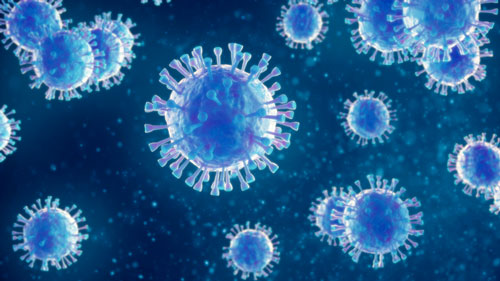The disease spread quickly, killing thousands of Americans a day.
Doctors had no effective treatments. There was no vaccine.
Parts of the country were locked down. The economy ground to a halt. Politicians were divided on whether to enforce quarantines or go about business as usual.
The year was 1918. Spanish flu was ravishing the nation. Although today’s COVID-19 crisis seems unprecedented, it’s not.
“The questions they asked then are the questions being asked now,” said Christopher Nichols, an associate professor of history at Oregon State University. “History provides a simple straightforward lesson for the present.”[1]
The coronavirus pandemic actually pales in comparison to the carnage caused by the Spanish flu. It was by far the worst pandemic in world history, said E. Thomas Ewing. He’s a history professor at Virginia Tech University.
The first three waves of Spanish flu killed 675,000 Americans and at least 50 million people around the world. The recent COVID-19 death count is more than 56,000 in the U.S. and over 210,000 worldwide.
With Spanish flu, doctors had no idea what they were dealing with. They understood the disease was transferred person-to-person through coughing and sneezing. But “they didn’t even know it was a virus,” Professor Ewing said. “Viruses weren’t discovered until the 1930s, because they didn’t have powerful enough microscopes.”
We have inadequate testing for today’s crisis. But back then, they had none at all. As with the older crisis, there is so far no vaccine or proven treatment. And there are concerns that the healthcare system could become overburdened and collapse.
Then, as now, social distancing is the most effective response.
“It was called ‘crowding’ control back then,” Professor Nichols said. “But whatever you call it, limiting contact worked in 1918…and it works today.”
The faster things are shut down and people shelter in place, the faster a pandemic can be brought to heel. This was hard for many people to accept during the Spanish flu, as it is today.
In 1918, the New York City health commissioner tried to slow the spread by ordering businesses to open and close in staggered shifts to avoid overcrowding the subways.[2]
Carolyn Orbann is a medical anthropologist at the University of Missouri. She said many people resisted such measures. She points to letters written at the time. “The mother is saying, ‘We all need to be patient, lay low, and wait it out.’ While the daughter is saying she’s had enough of no school and no friends, and she’s planning a Halloween party, just as the highest number of deaths are happening.”
As with today, the federal government did not take the leading role in responding to the pandemic. That “left cities and states to go off on their own and make decisions for themselves,” explained Professor Nichols.
Some cities, like St. Louis imposed a strict lockdown within 48 hours of its first Spanish flu case. It had a far lower death rate than Boston, New Orleans, and Philadelphia, which had less stringent quarantines.
Three Lessons the Spanish Flu Epidemic Can Teach Us
- Social distancing works. During the first wave of the Spanish flu, people stopped distancing too soon. That led to a second wave. It was deadlier than the first.
In San Francisco, disease cases were nearly brought to zero, epidemiologist Dr. Larry Brilliant said. “The city fathers said, ‘Let’s open up the city. Let’s have a great big parade downtown. We’ll all take off our masks together.’”
Due to that rash decision, two months later, “the great influenza” came roaring back.[3]
Something similar happened in Philadelphia. About 600 sailors from the Philadelphia Navy Yard had the Spanish flu. But the city carried on with a scheduled parade.[4]
Over the next month, the disease took more than 10,000 lives in Philadelphia. St. Louis, with stricter quarantining, kept its death toll below 700.[5] - Don’t use unproven treatments. People were desperate for Spanish flu treatments. That led to quack cures that did nothing or actually harmed patients.[6]
Today, unproven remedies and misinformation are again rampant. Colloidal silver was sold as a coronavirus cure until the federal government shut it down. There’s no evidence it works. In India, cow urine was touted as an effective treatment. And there are widely shared false reports on the internet that 5G cell phone networks cause COVID-19.[7] [8] - This will end. History professor Susan Kent is the author of The Influenza Pandemic of 1918–1919. She says the coronavirus death toll will not approach that of the Spanish flu. She says we have a head start, because “this is the first pandemic of this scope where we have known what the pathogen is from the very start.”[9]
The coming months will be painful, Professor Kent said. But she points to the work underway for treatments and a vaccine, the building of herd immunity, and continued social distancing as reasons to be hopeful.
The Spanish flu did not last forever, and the day when the coronavirus is under control may not be far away.
Editor’s Note: Discover the single best supplement for stronger immunity… The fruit extract that helps 93% of people with respiratory viruses get better in just two days… The germ hotspot that most of us forget to sanitize. Find all this and more in Independent Healing’s Coronavirus Pandemic Guide. Go HERE.
Related Articles
Takeout Food Is Safe…If You Do This
The Antidote to Coronavirus Sadness
Why an ED Drug
Might Work as a Coronavirus Treatment
Like this Article? Forward this article here or Share on Facebook.
[1]https://consumer.healthday.com/infectious-disease-information-21/coronavirus-1008/we-ve-been-here-before-lessons-from-the-1918-spanish-flu-pandemic-756844.html
[2] https://www.history.com/topics/world-war-i/1918-flu-pandemic
[3]https://www.cnn.com/2020/04/16/health/spanish-flu-coronavirus-lessons-learned/index.html
[4]https://archives.upenn.edu/exhibits/penn-history/flu
[5]https://www.cdc.gov/ncezid/dgmq/feature-stories/pandemic-flu-100.html
[6]https://virus.stanford.edu/uda/fluscimed.html
[7] https://www.theguardian.com/world/2020/apr/16/as-coronavirus-spreads-around-the-world-so-too-do-the-quack-cures
[8] https://www.insider.com/is-colloidal-silver-safe
[9]https://www.colorado.edu/today/2020/04/08/6-lessons-we-can-learn-past-pandemics

